- EraPtolemaic, Roman
- Project DirectorChristian Leitz
- LocationEsna
- AffiliationUniversity of Tuebingen
- Project SponsorAntiquites Endowment Fund The Ancient Egypt FoundationThe Gerda-Henkel-Foundation
- Project Dates: 2018 - Present
Written by: Christian Leitz
The temple of Khnum in the town of Esna is located approximately 27 miles / 45 km south of Luxor. Since Antiquity, it has been famed for the beauty of its location and the magnificence of its architecture. It was dedicated to the ram god Khnum, his consorts Menhit and Nebtu, their son Heka, and the goddess Neith and it is one of the very last examples of ancient Egyptian temple architecture ever built. It was constructed using red sandstone and is well known for its prominent pronaos built from six rows of four columns, each adorned with a uniquely-styled lotus-leaf capital.
The pronaos was mostly decorated during the Roman period (1st to 3rd centuries) but it is only the front part of the original temple complex which dated to the Ptolemaic period. The Ptolemaic temple proper has mostly been destroyed, but the pronaos survived because it was used as an industrial storage facility for cotton during the nineteenth century. The surviving walls and columns are famous for the complex programs of hieroglyphs, associated scenes, and colorful iconography that adorns them. Serge Sauneron published the texts displayed in the Esna temple between 1963 and 1975 with the final volume released posthumously in 2009.
In 2018, the University of Tübingen launched, in co-operation with the Egyptian Ministry of Antiquities (MoA, nowMoTA), a new documentation project in conjunction with the Documentation Center of the ministry under the direction of Hisham El-Leithy and financed in part by a generous grant from ARCE’s Antiquities Endowment Fund, which ran from 2019 until 2021.
The project‘s main objectives are twofold. The first objective is to continue the cleaning and conservation work started by the Department of Conservation under the direction of Gharib Sonbol, head of the Central Department of Restoration and Conservation of Antiquties some years ago. All of these activities are now carried out by a team of Egyptian conservators led by Ahmed Emam.
The second objective of the project is to compile a full photographic documentation set recording the current state of preservation of the architecture. The photographer responsible for carrying out this work is Ahmed Amin. In the long term we intend to publish plate volumes of all of the decoration in the pronaos in order to provide a set of images that complements the text volumes of the temple inscriptions so meticulously edited by Sauneron, and thus complete the publication of this famous temple.
Together with the temple of Hathor at Dendera, the temple of Khnum in Esna is a rare example of a greco-roman temple incorporating a large astronomical ceiling in the pronaos. As at Dendara, the ceiling is subdivided into three segments (bands) north and south of the main axis, separated in the middle by a larger section decorated with a double row of no fewer than forty six vultures, twenty four representing Nekhbet of Elkab as a crowned goddess of Upper Egypt and twenty two representing Wadjet of Buto as the crowned goddess of Lower Egypt. Both goddesses bear different heads and crowns appropriate to their domains. Nekhbet has a white hedjet crown on her vulture head, while Wadjet wears a red deshret crown on her cobra head.
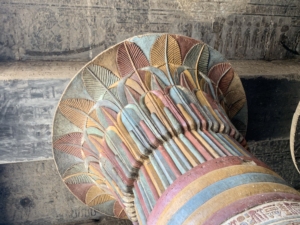
The capital of column 5. Above in the background is band D as it was before conservation. On its left is the bark with the scarab and the new born sun god just visible. Photo Ahmed Emam.
Apart from the capitals, all of the architraves carrying long astronomical texts are undergoing conservation treatment. The carved inscriptions are well known but it became clear that some parts were only painted on so that the conservation work revealed both the original colors and also new texts. The undersides of the architraves were almost entirely painted and were covered by such a thick layer of soot that Serge Sauneron was unable to read or integrate these texts in his famous edition.

Part of the second register of column 5 showing the litany for the goddess Menhit and the three stages of the conservation process, running from the original state on the left to completion at the right. Photo Ahmed Emam.
The eighteen columns are also part of the conservation project. So far, fifteen of these columns are completely restored. Esna is the only surviving temple with long texts in the second register of its columns. In all of the other temples, they are only decorated by offering scenes. The only exception is the temple of Athribis near Sohag where fragments of a second register is preserved. The inscriptions include hymns to the gods of Esna, especially Khnum, and very detailed descriptions of the feasts held during the year.

The lower side of architrave D during the conservation process with so far untranslated painted inscriptions. Photo Ahmed Emam.
The hieroglyphs there were created in three steps. The first step was drawing the texts in ink on the column, the second was carving the forms, and the final one was painting them. Sauneron‘s printed edition documented the second phase of the decoration but it sometimes happened that the carving was wrong and was corrected during the final phase by painting; something that Sauneron could not see. The conservation of all the columns will enable us to improve the edition of the Esna texts in this respect.
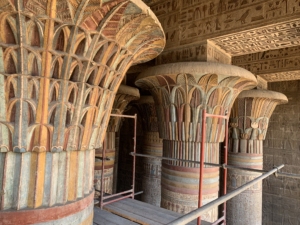
The capitals of the northern part of the pronaos after conservation. Note also the undersides of the architraves with painted inscriptions that were covered by soot and not readable before conservation. Photo Ahmed Emam.
A considerable challenge for all the conservation work carried out on the columns and walls are the many birds that frequent the pronaos, most notably the pigeons. Only the ceiling and the lower sides of the architraves are protected against them. For this reason, the mission is installing metalic spikes on top of the capitals, a favourite nesting place for the pigeons.
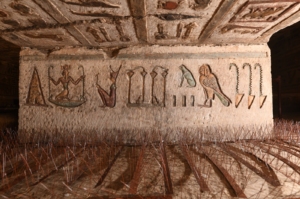
The grand vision for the future is the complete conservation of the inner part of the pronaos. At present, the complete ceiling (including bands E and F) and all
architraves including their lower sides are finished. Half of the columns are already protected against birds by metallic spikes fixed on their capitals.
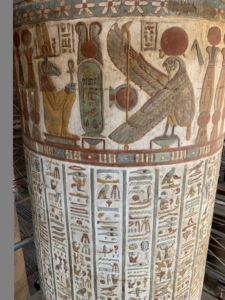
Column 4 after conservation. The cartouche in the frieze contains the name of the local child god Heka who is designated as the first born of the god Khnum (sitting to the left). Below are parts of the litany for Khnum. Photo Ahmed Emam.
All in all, the outstanding work should require two or three years to complete, depending on the financial and human resources available.
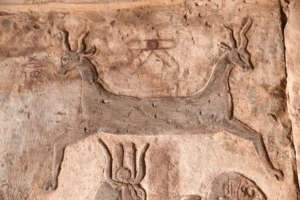
Band A. An unknown constellation of the southern sky in form of a double goat. In front of the left head is a painted inscription in red ink of its name. Photo Ahmed Amin.
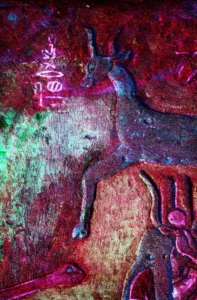
The unknown constellation with the goat reworked using the DStrech© program. Photo Ahmed Amin.